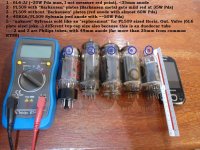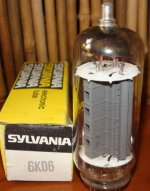Could you please share the simulation file? You are referring to the 6HJ5 not 6GE5, right?80mA, 23.5W P-Diss, 420 ohm Rp, 3k5 p-p, 300v +B, looking at 1.75 ohm O/P impedance before any NFB.
Reading through a load of old posts by Tubelab screwing the 6AV5/6GE5 types hints at the G2 max 220V can be exceeded a fair amount on these sweep tubes, but I think 300V is a reasonable amount, and we know sweep-tubes max plate diss is very conservative anyway, hence running a 24W tube at 23.5W...
Allegedly 19.6W RMS, and 0.182 H3, G1 stays negative by -2v at peaks--all with pinch of salt as this is results of a sim....
Not shabby though, wonder how will play in real life...
Yes--Its the 6HJ5 tube.
Here is the TCJ file--
Hmm--It wont upload,--File-type doesn't comply with Forum system....
Here is the TCJ file--
Hmm--It wont upload,--File-type doesn't comply with Forum system....
There is something odd about the report, if you look at the triode curves from smoking-amp or other sources, at Ep=300V, Eg=-52V, Ip should be much higher than 80mA.😕It will however attach a PDF, so that'll have to do for now, Maybe give you idea of whats what...
Hmm--There's summit fishy for sure....
Not being very up on simulations--Ive prolly done summit daft somewhere, I have a feeling its to do with the Transconductance....
Any ideas....?
Not being very up on simulations--Ive prolly done summit daft somewhere, I have a feeling its to do with the Transconductance....
Any ideas....?
There is something odd about the report, if you look at the triode curves from smoking-amp or other sources, at Ep=300V, Eg=-52V, Ip should be much higher than 80mA.😕
Something like 140mA right? Because that's what I see.
Ep=300 and Ip=80mA Eg= -60
Famous--
Do you think its something to do with the simulation transconductance...?
The prog recons 10mA/V and there's no input box for that, only the other values like Mu, Rp etc...
Do you think its something to do with the simulation transconductance...?
The prog recons 10mA/V and there's no input box for that, only the other values like Mu, Rp etc...
Something like 140mA right? Because that's what I see. Ep=300 and Ip=80mA Eg= -60
Just to make sure we are looking at the same chart, which one are you looking at?
Last edited:
Just to make sure we are looking at the same chart, which one are you looking at?
7v steps for g1, 50V/div horizontal, 50mA/div vertical. LTspice sims show the same results
Attachments
In any case, the best way to find out for sure is to breadboard the circuit with an actual tube.
Working on it

I am trying to get this TSA1 "transistorized" amplifier for a Seeburg Jukebox up and running before a up coming party in a couple weeks. It's a real mess, there was mice nesting in the area around the upper speakers. All original caps etc..... I might need help and god for bid post in the solid state section😱
New money: Tubecoin 😛😀😀Sweep tubes........the next Bitcoin, Hey I'm rich......only if your net worth is measured in watts of plate dissipation!
I have some of both, but you know which one is my favorite tube.
This thread is about the 6GE5...Right before I left Florida I had wired up a test amp using a newly designed driver board that resembles the circuit in the 6L6GC in AB2 design. I also had some tag boards wired up in octal, novar, noval, and Compactron pairs, and I have some 6GE5's........I wonder which boxes all that stuff is in. I have nearly finished building the first workbench, and most of the wood was cut for the second yesterday before the rain came......I'ts been far too long since I melted a tube or two.
One of my favorite topics: messing with sweep tubes
I have a box full of PL509, so I fell at home...
Serves for my plasma tweeters and my PP amp: very versatile tube (like most sweep tubes)! The huge plate permits high Pda (~60W on some types) unless it have Barkhausen plates: the Barkhausen fins goes red with only 35W 😡 .
NOTE: The "#5" tube is an duodecar used in some colour TV replacing some PL509-sized 12-pin tube. Magic? Or crazy service technician (error)?
(please excuse some potential errors)
Attachments
I think tube #5 must be a "crazy service technician (error)". If you post what pins are connected to what, we can probably decode what tube it actually is.
Likely one of: 6JE6, 6JS6, 6HF5, 6LQ6, 6LG6, 6ME6
Likely one of: 6JE6, 6JS6, 6HF5, 6LQ6, 6LG6, 6ME6
I take some minutes messing with that tube and...I think tube #5 must be a "crazy service technician (error)". If you post what pins are connected to what, we can probably decode what tube it actually is.
Likely one of: 6JE6, 6JS6, 6HF5, 6LQ6, 6LG6, 6ME6
#pinout is equal to 6KD6:
1 and 12 = filament (obvious for compactron 12-pin tubes)
2 - cathode
3 and 11 - G2
4 and 10 - G3
5 and 9 - G1
6, 7 and 8 = i.c. (internally not connected)
plate is at top
Because of this pinout maybe that TV servicemen tried to apply it in place of 36KD6, an PL509-sized tube, in a crazy attempt, maybe... or some color TV used this little sweep tube (an little mystery for a young guy like me)?
#is Sylvania brand (...YLVA... is barely visible with typical Sylvania font), with 3 medium-sized slots
#has some 36K.../40K... markings; the second missing letter has some vertical "at left", like M, L, D, B etc letters, so it can be 6KDx, 6KMx, 6KBx, etc...
#don't have more markings, is all erased
When I have some time I can measure them at µTracer (now I curious to know).
Well the pinout connections match the 12GW base for 36/40KD6, however the top plate cap size is too big for KD6. And the plate size is too small for KD6. See 6KD6 pic below. Pin 7 is likely a heater mid connection.
Some other bases like 12FB, 12FY, 12GJ, 12GU, and 12JA can also meet the pinout by using the undocumented "IC" connections. But none of them have a 36/40... tube version.
Also, bases 12GD, 12GH and 12GM using IC pins. Base 12GM has pin 7 connected to g2
A mystery, unless someone soldered a different plate cap on the tube.
Some other bases like 12FB, 12FY, 12GJ, 12GU, and 12JA can also meet the pinout by using the undocumented "IC" connections. But none of them have a 36/40... tube version.
Also, bases 12GD, 12GH and 12GM using IC pins. Base 12GM has pin 7 connected to g2
A mystery, unless someone soldered a different plate cap on the tube.
Attachments
Last edited:
Thanks for the infos! So is really an mystery tube...
The solder in top cap has a little "mess", but is firmly in place. I can check this better. Anyway, this top seems to be same type from HV rectifier tubes...
...some thoughts about code: maybe is some fake glass markings from some cheater seller, or even a left-over for fulfill some contract (military, etc) etc...
Reading the manuals it seems to be some 1/2 6KN6 (but pins 9 and 11 is not used for 6KN6) or an 12-pin version of 6KM6. Maybe some local brand here ordered a model with different pinout for Sylvania?
Tomorow I finally will have a spare time to use the µtracer, but it measures only to 200mA, so I can need to extrapolate/estimate the real high current knee.
About 6DK6, 4 years ago I made a 14W SE with CFB stereo amp with them (the 36KD6 version). I have used some GE specimen, a little different from Sylvania, and the top cap is same from your photo.
The solder in top cap has a little "mess", but is firmly in place. I can check this better. Anyway, this top seems to be same type from HV rectifier tubes...
...some thoughts about code: maybe is some fake glass markings from some cheater seller, or even a left-over for fulfill some contract (military, etc) etc...
Reading the manuals it seems to be some 1/2 6KN6 (but pins 9 and 11 is not used for 6KN6) or an 12-pin version of 6KM6. Maybe some local brand here ordered a model with different pinout for Sylvania?
Tomorow I finally will have a spare time to use the µtracer, but it measures only to 200mA, so I can need to extrapolate/estimate the real high current knee.
About 6DK6, 4 years ago I made a 14W SE with CFB stereo amp with them (the 36KD6 version). I have used some GE specimen, a little different from Sylvania, and the top cap is same from your photo.
Last edited:
You might try the heater on 36V to see if it lights up correctly. ( try 6.3 V first!) If it were 6.3V, then maybe: 6JS6, 6HF5, 6LG6, 6LB6, 6KE6, 6GY5 or possibly 16KA6
Measuring the heater current at whatever V(htr) looks like normal heater brightness could give a clue.
Also, could measure the plate knee current with 150V on g2, 0V on g1, and 60V on the plate. Then find it in the table: (although there is probably significant variation from tube to tube in the same type) (or could also measure the g2/g1 Mu by varying g1 by -1V and counter varying g2 by +Mu V to get the same current)
Then there is always just looking at the pics on Ebay to see what looks like the exact same tube.
List of knee currents for g2 = 150 V, g1 = 0 V, Vp = 60 to 80 V
<tube> <Watts> <mA knee@150Vg2> <gm> <Mu> <maxDCmA> <registered by> <date>
6LF6 40W 1144mA@150V 15K@125mA Mu3 500mADC Amperex 1968
6KG6/EL509 34W 1135mA@150V 13K@150mA Mu3.2 500mADC Amperex 1965
6MC6 33W 1130mA@150V 14K@125mA Mu4 400mADC RCA (6LX6 clone) 1972
13E1 90W(absmax) 1120mA@150V 35K@500mA Mu4.5 800mADC AEI 1961
6MH6 38.3W 1100mA@150V 14K@125mA Mu4 500mADC GE (up-rated 6LX6,6KD6,26HU5) 1972
6MB6 38W 1085mA@150V 14K@110mA Mu3.5 400mADC Sylvania 1971
6LR6 30W 1085mA@150V 16K@140mA Mu3.5 375mADC Sylvania 1968
6LX6/6KD6/26HU5 33W 1080mA@150V 14K@125mA Mu4 400mADC GE 1969/1965/1969
6LW6 40W 1050mA@150V 12K@125mA Mu3.7 400mADC GE 1971
6KN6 30W 1050mA@150V 16K@100mA Mu4.5 400mADC Sylvania 1965 (later versions are 6KD6)
6LZ6 30W 940mA@150V 11K@140mA Mu3 350mADC RCA 1971
6LB6/A 30W/35W 825mA@150V 13.4K@105mA Mu4 315mADC GE 1967
6JE6C/6JS6C 30W 789mA@150V 10.5K@130mA Mu3 350mADC Sylvania 68/69
6JE6 24W 762mA@150V 9.6K@115mA Mu3 315mADC RCA 1962
6JS6/6HF5 28W 749mA@150V 11.5K@130mA Mu3 315mADC GE 1964/1963
6MJ6 30W 740mA@150V 11K@100mA Mu3.6 350mADC RCA 1973
6LG6 28W 740mA@150V 11.5K@90mA Mu3.6 315mADC GE 1967
6LQ6 30W 715mA@150V 7.5K@95mA Mu3 350mADC RCA 1967
6ME6 30W 700mA@150V 9.6@130mA Mu3.5 350mADC RCA 1971
6DQ5 24W 690mA@150V 10.5K@110mA Mu3.3 315mADC RCA 1957
6JF6/6JG6 17W 660mA@150V 10K@80mA Mu4.1 275mADC RCA 1965/1964
6KM6 20W 630mA@150V 9.5K@80mA Mu4 275mADC RCA 1965
6HD5/6HJ5 24W 630mA@150V 10K@80mA Mu4.2 280mADC Raytheon 1962/1963
6JR6/6JU6 17W 600mA@150V 7K@45mA Mu4.7 275mADC RCA 1968/1966
6JZ6/21HB5A 18W 560mA@150V 9K@46mA Mu4.8 230mADC GE 1966/1964
12HE7 10-15W 540mA@150V 8.8K@60mA Mu4.2 200mADC GE (15W if damper disabled) 1964
6CL5 25W 514mA@150V 6.5K@90mA Mu3 240mADC Sylvania 1955
6GB5/29KQ6/EL500 17W 500mA@150V 13K@100mA Mu5.1 275mADC Amperex 1961/Matsushita 1959/Philips 1961?
6KV6/A 20-28W 488/610mA@150V 6K@40mA Mu4 275mADC RCA (re-rated 6KM6?) 1967/1969
6HB5/6GY5/21JV6/6KE6/16KA6 18W 475mA@150V 9.1K@50mA Mu4.7 230mADC GE/GE/GE/Ray/Tung 1962/1962/1965/1965/1964
6EX6 22W 460mA@150V 7.7K@67mA Mu4.2 220mADC Raytheon (up-rated 6CD6) 1959
6CB5/A 23W 440mA@150V 8.8K@90mA Mu3.8 240mADC RCA 1954/1956
6CD6/GA 15/20W 422mA@150V 7.7K@75mA Mu3.9 200mADC RCA/GE 1949/1954
6GT5/6GJ5/6JT6/6JB6/6GW6 17.5W 380mA@150V 7.1K@70mA Mu4.4 175mADC RCA 1961/1961/1964/1962/1961
6GE5 17.5W 350mA@150V 7.3K@65mA Mu4.4 175mADC GE 1961
6GF5 9W 345mA@150V 4.7K@34mA Mu4.2 160mADC GE 1961
6JM6/6JN6/6FW5/6GC6 17.5W 340mA@150V 7.3K@70mA Mu4.4 175mADC GE 1964/1964/1960/1960
6DQ6B/6GV5 17.5W/18W 330mA@150V 7.3K@65mA Mu4.4 175mADC GE 1959/1962
6DQ6/A 18W 280mA@150V 6.6K@55mA Mu4.1 120/155mADC CBS/RCA 1955/1956
6JA5/10JA5 19W 276mA@150V 10.3K@95mA Mu5.5 110mADC GE 1971
6LU8/6LR8//6MY8 14//16W 265mA@150V 9.3K@56mA Mu6.5 75mADC Sylvania 1964/1964//1970(Toshiba)
6AV5/GA///6BQ6/GA 11W 255ma@150V 5.9K@57mA Mu4.3 110mADC CBS/GE 1949/1955 /// CBS/Syl 1949/1953
KT120 60W 221ma@150V 190mADC
KT90 50W 220mA@150V
6Y6G/GT/GA 12.5W 200mA@150V Ray 1937/KenRad 1939/Syl 1954
6550A 35W/42W 190mA@150V 11K@140mA 190mADC
6W6GT 10W 185mA@150V 8K@46mA Mu6.2 65mADC CBS 1939
KT88 35W 170mA@150V 175mADC
6CA7/EL34 25W 107mA@150V 11K@100mA Mu10.5 150mADC Philips 1952
6JC5 19W 80mA@150V 4.1K@43mA Mu7 75mADC Sylvania 1971
6L6/G/GA/GB/GC 30W 77mA@150V 4.7K@40mA Mu8 110mADC RCA 1936/Ray 1936/Syl 1943/Syl 1954/GE 1958
6HB6 10W 70mA@150V 20K@40mA Mu33 60mADC Raytheon 1961
6GK6 13.2W 65mA@150V 11.3K@48mA Mu19 65mADC CBS 1959
6BQ5/EL84 12W 65mA@150V 11.3K@48mA Mu19.5 65mADC Rogers 1956
6V6G/GT 14W 45mA@150V 4.1K@45mA Mu9.8 40mADC KenRad 1936/CBS 1939
Measuring the heater current at whatever V(htr) looks like normal heater brightness could give a clue.
Also, could measure the plate knee current with 150V on g2, 0V on g1, and 60V on the plate. Then find it in the table: (although there is probably significant variation from tube to tube in the same type) (or could also measure the g2/g1 Mu by varying g1 by -1V and counter varying g2 by +Mu V to get the same current)
Then there is always just looking at the pics on Ebay to see what looks like the exact same tube.
List of knee currents for g2 = 150 V, g1 = 0 V, Vp = 60 to 80 V
<tube> <Watts> <mA knee@150Vg2> <gm> <Mu> <maxDCmA> <registered by> <date>
6LF6 40W 1144mA@150V 15K@125mA Mu3 500mADC Amperex 1968
6KG6/EL509 34W 1135mA@150V 13K@150mA Mu3.2 500mADC Amperex 1965
6MC6 33W 1130mA@150V 14K@125mA Mu4 400mADC RCA (6LX6 clone) 1972
13E1 90W(absmax) 1120mA@150V 35K@500mA Mu4.5 800mADC AEI 1961
6MH6 38.3W 1100mA@150V 14K@125mA Mu4 500mADC GE (up-rated 6LX6,6KD6,26HU5) 1972
6MB6 38W 1085mA@150V 14K@110mA Mu3.5 400mADC Sylvania 1971
6LR6 30W 1085mA@150V 16K@140mA Mu3.5 375mADC Sylvania 1968
6LX6/6KD6/26HU5 33W 1080mA@150V 14K@125mA Mu4 400mADC GE 1969/1965/1969
6LW6 40W 1050mA@150V 12K@125mA Mu3.7 400mADC GE 1971
6KN6 30W 1050mA@150V 16K@100mA Mu4.5 400mADC Sylvania 1965 (later versions are 6KD6)
6LZ6 30W 940mA@150V 11K@140mA Mu3 350mADC RCA 1971
6LB6/A 30W/35W 825mA@150V 13.4K@105mA Mu4 315mADC GE 1967
6JE6C/6JS6C 30W 789mA@150V 10.5K@130mA Mu3 350mADC Sylvania 68/69
6JE6 24W 762mA@150V 9.6K@115mA Mu3 315mADC RCA 1962
6JS6/6HF5 28W 749mA@150V 11.5K@130mA Mu3 315mADC GE 1964/1963
6MJ6 30W 740mA@150V 11K@100mA Mu3.6 350mADC RCA 1973
6LG6 28W 740mA@150V 11.5K@90mA Mu3.6 315mADC GE 1967
6LQ6 30W 715mA@150V 7.5K@95mA Mu3 350mADC RCA 1967
6ME6 30W 700mA@150V 9.6@130mA Mu3.5 350mADC RCA 1971
6DQ5 24W 690mA@150V 10.5K@110mA Mu3.3 315mADC RCA 1957
6JF6/6JG6 17W 660mA@150V 10K@80mA Mu4.1 275mADC RCA 1965/1964
6KM6 20W 630mA@150V 9.5K@80mA Mu4 275mADC RCA 1965
6HD5/6HJ5 24W 630mA@150V 10K@80mA Mu4.2 280mADC Raytheon 1962/1963
6JR6/6JU6 17W 600mA@150V 7K@45mA Mu4.7 275mADC RCA 1968/1966
6JZ6/21HB5A 18W 560mA@150V 9K@46mA Mu4.8 230mADC GE 1966/1964
12HE7 10-15W 540mA@150V 8.8K@60mA Mu4.2 200mADC GE (15W if damper disabled) 1964
6CL5 25W 514mA@150V 6.5K@90mA Mu3 240mADC Sylvania 1955
6GB5/29KQ6/EL500 17W 500mA@150V 13K@100mA Mu5.1 275mADC Amperex 1961/Matsushita 1959/Philips 1961?
6KV6/A 20-28W 488/610mA@150V 6K@40mA Mu4 275mADC RCA (re-rated 6KM6?) 1967/1969
6HB5/6GY5/21JV6/6KE6/16KA6 18W 475mA@150V 9.1K@50mA Mu4.7 230mADC GE/GE/GE/Ray/Tung 1962/1962/1965/1965/1964
6EX6 22W 460mA@150V 7.7K@67mA Mu4.2 220mADC Raytheon (up-rated 6CD6) 1959
6CB5/A 23W 440mA@150V 8.8K@90mA Mu3.8 240mADC RCA 1954/1956
6CD6/GA 15/20W 422mA@150V 7.7K@75mA Mu3.9 200mADC RCA/GE 1949/1954
6GT5/6GJ5/6JT6/6JB6/6GW6 17.5W 380mA@150V 7.1K@70mA Mu4.4 175mADC RCA 1961/1961/1964/1962/1961
6GE5 17.5W 350mA@150V 7.3K@65mA Mu4.4 175mADC GE 1961
6GF5 9W 345mA@150V 4.7K@34mA Mu4.2 160mADC GE 1961
6JM6/6JN6/6FW5/6GC6 17.5W 340mA@150V 7.3K@70mA Mu4.4 175mADC GE 1964/1964/1960/1960
6DQ6B/6GV5 17.5W/18W 330mA@150V 7.3K@65mA Mu4.4 175mADC GE 1959/1962
6DQ6/A 18W 280mA@150V 6.6K@55mA Mu4.1 120/155mADC CBS/RCA 1955/1956
6JA5/10JA5 19W 276mA@150V 10.3K@95mA Mu5.5 110mADC GE 1971
6LU8/6LR8//6MY8 14//16W 265mA@150V 9.3K@56mA Mu6.5 75mADC Sylvania 1964/1964//1970(Toshiba)
6AV5/GA///6BQ6/GA 11W 255ma@150V 5.9K@57mA Mu4.3 110mADC CBS/GE 1949/1955 /// CBS/Syl 1949/1953
KT120 60W 221ma@150V 190mADC
KT90 50W 220mA@150V
6Y6G/GT/GA 12.5W 200mA@150V Ray 1937/KenRad 1939/Syl 1954
6550A 35W/42W 190mA@150V 11K@140mA 190mADC
6W6GT 10W 185mA@150V 8K@46mA Mu6.2 65mADC CBS 1939
KT88 35W 170mA@150V 175mADC
6CA7/EL34 25W 107mA@150V 11K@100mA Mu10.5 150mADC Philips 1952
6JC5 19W 80mA@150V 4.1K@43mA Mu7 75mADC Sylvania 1971
6L6/G/GA/GB/GC 30W 77mA@150V 4.7K@40mA Mu8 110mADC RCA 1936/Ray 1936/Syl 1943/Syl 1954/GE 1958
6HB6 10W 70mA@150V 20K@40mA Mu33 60mADC Raytheon 1961
6GK6 13.2W 65mA@150V 11.3K@48mA Mu19 65mADC CBS 1959
6BQ5/EL84 12W 65mA@150V 11.3K@48mA Mu19.5 65mADC Rogers 1956
6V6G/GT 14W 45mA@150V 4.1K@45mA Mu9.8 40mADC KenRad 1936/CBS 1939
Last edited:
Sylvania was famous for stuffing the glass envelope with anything that worked in a particular circuit to fulfill contract obligations as tube manufacturing lines were shut down. Your mystery tube could be something made special for a TV set manufacturer in Brazil of another SA country.
There are several well known cases of envelope stuffing for the US government, but I have found examples in TV tubes too. Some TV sweep tubes were used in military equipment but these were always 6 or 12 volt heater versions.
The popular examples are 6BG6's with 7027A guts inside.
Several vintages of 807's came with 6L6GC and 7027 guts.
There is a 6B4GA tube (should be a DHT) with 6AV5 sweep tube guts inside, wired as a triode! If Sylvania could make this, they are capable of just about anything.
I have found several examples of 6CW5's with internals that could NEVER meet the 12 watt plate dissipation rating. The guts were too small, and red plated badly at 8 watts. I have examples in Sylvania brand, and Philips ECG brand that are the same tube. I also have a pair that are Canadian GE or RCA (don't remember which) with even smaller guts.
The tube guts inside the glass in your picture looks like a Sylvania 6DQ5 which is an octal based tube. A 26 volt version was made, but I don't think there was a 36 volt version.
There are several well known cases of envelope stuffing for the US government, but I have found examples in TV tubes too. Some TV sweep tubes were used in military equipment but these were always 6 or 12 volt heater versions.
The popular examples are 6BG6's with 7027A guts inside.
Several vintages of 807's came with 6L6GC and 7027 guts.
There is a 6B4GA tube (should be a DHT) with 6AV5 sweep tube guts inside, wired as a triode! If Sylvania could make this, they are capable of just about anything.
I have found several examples of 6CW5's with internals that could NEVER meet the 12 watt plate dissipation rating. The guts were too small, and red plated badly at 8 watts. I have examples in Sylvania brand, and Philips ECG brand that are the same tube. I also have a pair that are Canadian GE or RCA (don't remember which) with even smaller guts.
The tube guts inside the glass in your picture looks like a Sylvania 6DQ5 which is an octal based tube. A 26 volt version was made, but I don't think there was a 36 volt version.
Yesterday I had time to play with the tube and ...
I bet in Tubelab alternative: despite the presence of 36Kxxx / 40Kxxx faint markings, the filament is orange with 36V (and 500mA), and to reach the nearest nominal current standard is necessary to apply 26V (and thus gets 450mA) . With this current the cathode have normal appearance/bright.
I trace the tube with the μTracer and the result indicated an anomaly, possibly gas, which was confirmed with trying to measure current saturation with 70V at anode and 140V in g2 (fixed PSU's, so I could not use the exactly values suggested by smoking-amp). The measured values are only 160mA at anode and 100mA in g2, with bright internal glow of death (between cathode-anode). At least the μTracer allowed to have an idea of μ and other parameters. Since the tube are gaseous and used, the mystery remains 😀 ...
I bet in Tubelab alternative: despite the presence of 36Kxxx / 40Kxxx faint markings, the filament is orange with 36V (and 500mA), and to reach the nearest nominal current standard is necessary to apply 26V (and thus gets 450mA) . With this current the cathode have normal appearance/bright.
I trace the tube with the μTracer and the result indicated an anomaly, possibly gas, which was confirmed with trying to measure current saturation with 70V at anode and 140V in g2 (fixed PSU's, so I could not use the exactly values suggested by smoking-amp). The measured values are only 160mA at anode and 100mA in g2, with bright internal glow of death (between cathode-anode). At least the μTracer allowed to have an idea of μ and other parameters. Since the tube are gaseous and used, the mystery remains 😀 ...
Attachments
-
 Mystery tube 26V 450mA filament triode test.png28.5 KB · Views: 82
Mystery tube 26V 450mA filament triode test.png28.5 KB · Views: 82 -
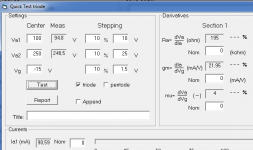 Mystery tube 36V 500mA filament triode test.png26.9 KB · Views: 90
Mystery tube 36V 500mA filament triode test.png26.9 KB · Views: 90 -
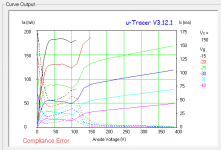 Mystery tube 36V 500mA filament.png16.8 KB · Views: 109
Mystery tube 36V 500mA filament.png16.8 KB · Views: 109 -
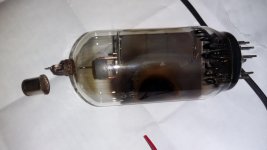 20150901_222453.jpg322.4 KB · Views: 1,115
20150901_222453.jpg322.4 KB · Views: 1,115 -
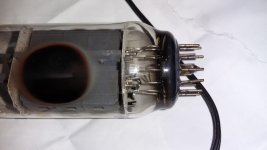 20150901_222557.jpg340.7 KB · Views: 1,184
20150901_222557.jpg340.7 KB · Views: 1,184 -
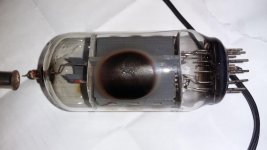 20150901_222609.jpg336.2 KB · Views: 1,196
20150901_222609.jpg336.2 KB · Views: 1,196 -
 Mystery tube 26V 450mA filament.png15.7 KB · Views: 95
Mystery tube 26V 450mA filament.png15.7 KB · Views: 95
- Status
- Not open for further replies.
- Home
- Amplifiers
- Tubes / Valves
- 6GE5 Triode

